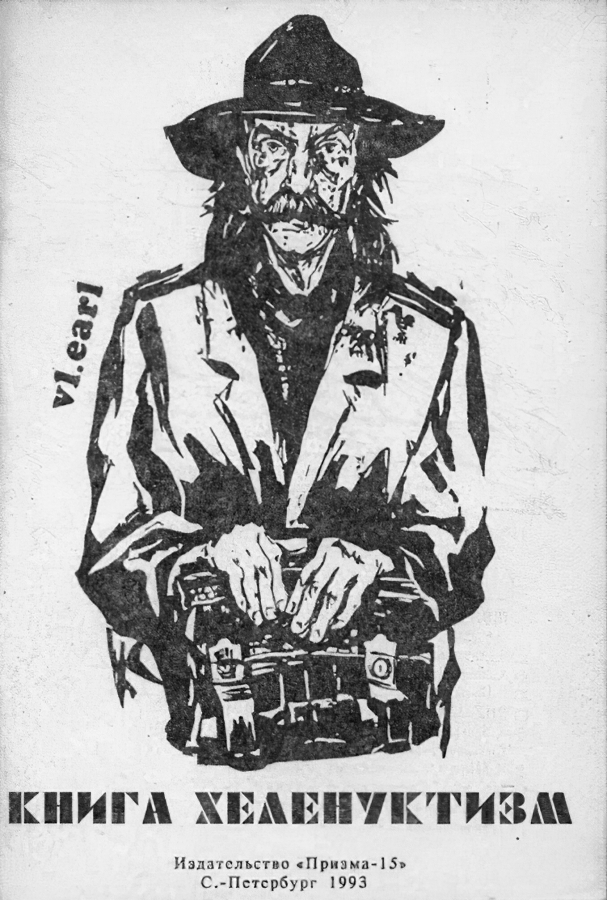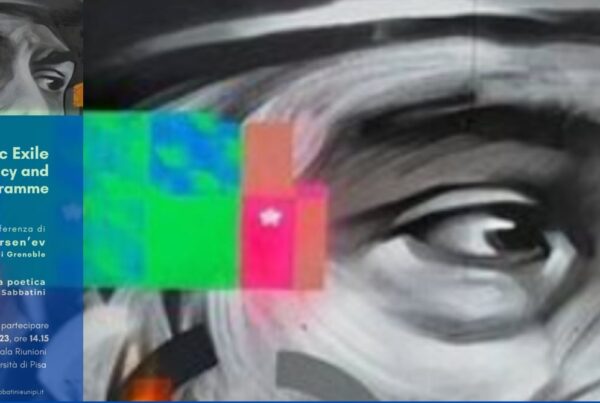
Vladimir Ėrl’. Kniga Khelenuktizm, 1993.
Dates: 1966–1972
Place: Leningrad
Founders: Vladimir Erl’, Dmitrii Makrinov
Members: Aleksandr Mironov, Nataliia Fediuchek, Sergei Dorofeev, Aleksei Khvostenko, Viktor Nemtinov
Publishing initiatives: Pol’za and Palata mer i vesov editions
Description:
The Khelenukty group was founded in September 1966 by the poets Dm. M. and Vladimir Ėrl’ (pseudonyms of Dmitrii Makrinov and Vladimir Gorbunov) and was the result of a series of important events in the preceding months: in May 1965 two regular visitors to Malaia Sadovaia, Aleksandr Mironov and Vladimir Ėrl’, had gone to Moscow to visit the poets of the newly created SMOG group, with a view to collaborating on an issue of the tamizdat journal “Grani”, published in Frankfurt am Main. The attempt, which would have established a link between the Moscow and Leningrad undergrounds, was thwarted by the KGB (cf. Savitskii 2002: 22-23) but not long after this disappointment, Ėrl’ founded the independent publishing house Pol’za, that during the following five years published more than seventy works. The Khelenukty’s Introductory Article (Vstupitelnaia stateika Khelenuktov), which represents a manifesto for the group, appeared the following year, on 16th September 1966, outlining the shared poetic principles of the writers. The manifesto is not a conventional list of common cultural goals as much as a description of ordinary daily actions (‘strolling’, ‘laughing’, ‘taking a bath’, ‘singing’, ‘going to the bania‘, etc.), which are subjected to a process of aestheticization (cf. Parisi 2013: 205), and which gain value and meaning thanks to the act of sharing. The Khelenukty group made great use of collage, a technique borrowed from Dada (cf. Savitskii 2002: 82), which mixes heterogeneous linguistic registers (from the sublime to the popular, from bureaucratic clichés to foul language) and placed great emphasis on the process of co-writing which is evident not only in their poetry, but also in their prose miniatures, the so-called dramagedii (dramagedias) cf. Dolinin 2003: 461). Their rich and frequent use of cryptonyms places the group’s writers in the larger context of the Malaia Sadovaia. A certain aura of mystery surrounds the name of the group, whose significance is enigmatic even today. The continuous adoption of disguises and of seeking to carnivalize reality (cf. Parisi 2013: 205), is recognizable in the activity of other groups of the period, such as the Filologicheskaia shkola.
The depiction of existence in terms of the absurd can be traced to the historical Russian avant-garde, the OBĖRIU, whose ideas were spread by the Khelenukty in underground networks. The influence of Western writers should not be forgotten, such as Dada (cf. Sabbatini 2007: 187), Beckett and Ionesco’s and the nineteenth-century comic tradition of Koz’ma Prutkov and Count Khvostov was also important (cf. Savitskii 2002: 38). The toponyms that appear on the title pages of the volumes are fictional; the books were published first by Pol’za and then by the Palata mer i vesov (Chamber of measurements and weights, 1970-1978, which published about thirty titles), both of which were guided by Ėrl’’s creative and organizational genius. The volumes published by Ėrl’, “the Paganini of the typewriter” in Boris Konstriktor’s opinion, deserve being remembered today for their fine graphic workmanship, which is far superior to the samizdat editions (cf. Parisi 2013: 207). Several writers collaborated with the group, including Leonid Aronzon and Konstantin Kuz’minskii. The group is also remembered as Moguchaia kuchka (The mighty little group). The theoretical document entitled On the Occasion of the Publication of the First Edition of the Almanac of the Mighty Group (K vykhodu 1-go vypuska Almanakha Moguchei Kuchki) was written for inclusion in an almanac that failed to be published. Fortunately, the document was preserved and is now available. The Mit’ki, the Khelenukty group’s fellow citizens, can be considered their almost direct descendants (cf. Caramitti 2010: 151).
Federico Iocca
[30th June 2021]
Translation by Alice Bucelli
Bibliography
- Caramitti M., Letteratura russa contemporanea: La scrittura come resistenza, Laterza, Bari 2010.
- Dolinin V., Ivanov B., Ostanin B., Severiukhin D. (eds.), Samizdat Leningrada. Literaturnaia ėntsiklopediia, Novoe Literaturnoe Obozrenie, Mosca 2003.
- Kislov V., Goriukhaia smes’, “Novoe Literaturnoe Obozrenie”, 143 (2017), https://www.nlobooks.ru/magazines/novoe_literaturnoe_obozrenie/143_nlo_1_2017/article/12373/ online (last accessed: 30/06/2021).
- Parisi V., Il lettore eccedente. Edizioni periodiche del samizdat sovietico, 1956-1990, Il Mulino, Bologna 2013.
- Sabbatini M., “Folle e il mio aspetto e la mia indole e sfrenata”. Dialogo con Vladimir Ėrl’, “eSamizdat”, 5.1-2 (2007): 185-188.
- Savitskii S., Andegraund. Istoriia i mify leningradskoi neofitsial’noi literatury, Novoe Literaturnoe Obozrenie, Mosca 2002.
To cite this article:
Federico Iocca, Khelenukty, in Voci libere in URSS. Letteratura, pensiero, arti indipendenti in Unione Sovietica e gli echi in Occidente (1953-1991), a cura di C. Pieralli, M. Sabbatini, Firenze University Press, Firenze 2021-, <vocilibereurss.fupress.net>.
eISBN 978-88-5518-463-2
© 2021 Author(s)
Content license: CC BY 4.0




